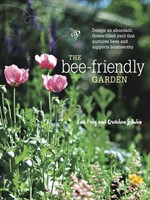The Bee-Friendly Garden
The Bee-Friendly Garden
by Kate Frey
In The Bee-Friendly Garden, award-winning garden designer Kate Frey and bee expert Gretchen LeBuhn provide everything you need to know to create a stunningly colorful, vibrant, safe, healthy garden that helps both the threatened honeybee and native bees. No matter how small or large your space, and regardless of whether you live in the city, suburbs, or country, just a few simple changes to your garden can fight the effects of colony collapse disorder and the worldwide decline in bee population that threatens our global food chain. There are many personal benefits of having a bee garden as well! Bee gardens:
· contain a gorgeous variety of flowers
· bloom continuously throughout the seasons
· are organic, pesticide-free, and ecologically sustainable
· develop healthy and fertile soil
· attract birds, butterflies, and other beneficial insects
· increase the quantity of your fruit and vegetable harvest
· improve the quality, flavor, and size of your produce
Illustrated with spectacular full-color photos, The Bee-Friendly Garden debunks myths about bees, explains seasonal flower progression, and provides detailed instructions for nest boxes and water features. From "super blooming" flowers to regional plant lists and plants to avoid, The Bee-Friendly Garden is an essential tool for every gardener who cares about the planet and wants to make their yard a welcoming habitat for nature's most productive pollinator.
From the Trade Paperback edition.
In The Bee-Friendly Garden, award-winning garden designer Kate Frey and bee expert Gretchen LeBuhn provide everything you need to know to create a stunningly colorful, vibrant, safe, healthy garden that helps both the threatened honeybee and native bees. No matter how small or large your space, and regardless of whether you live in the city, suburbs, or country, just a few simple changes to your garden can fight the effects of colony collapse disorder and the worldwide decline in bee population that threatens our global food chain. There are many personal benefits of having a bee garden as well! Bee gardens:
· contain a gorgeous variety of flowers
· bloom continuously throughout the seasons
· are organic, pesticide-free, and ecologically sustainable
· develop healthy and fertile soil
· attract birds, butterflies, and other beneficial insects
· increase the quantity of your fruit and vegetable harvest
· improve the quality, flavor, and size of your produce
Illustrated with spectacular full-color photos, The Bee-Friendly Garden debunks myths about bees, explains seasonal flower progression, and provides detailed instructions for nest boxes and water features. From "super blooming" flowers to regional plant lists and plants to avoid, The Bee-Friendly Garden is an essential tool for every gardener who cares about the planet and wants to make their yard a welcoming habitat for nature's most productive pollinator.
From the Trade Paperback edition.

